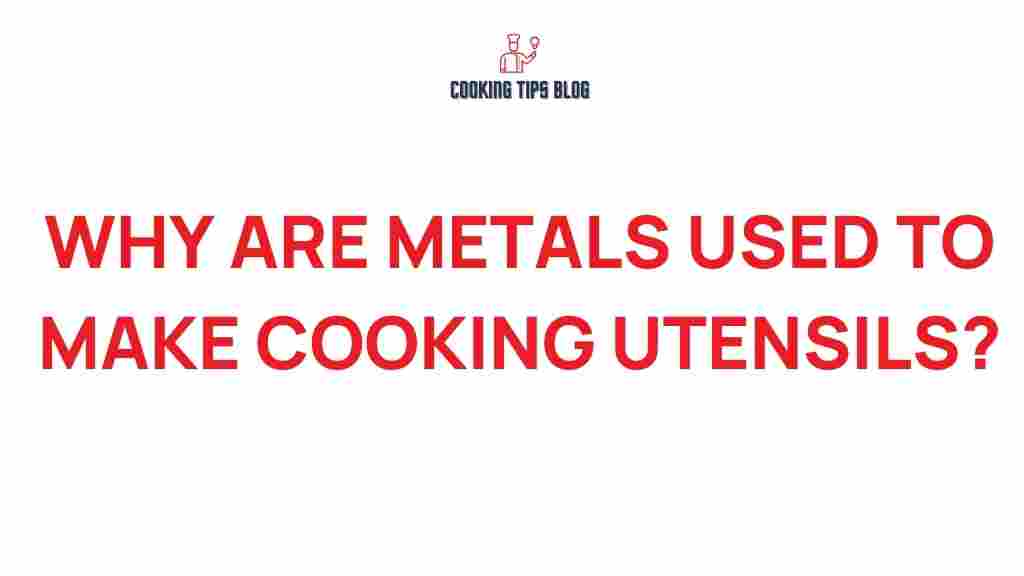Understanding Cooking Utensils: Why Metals Are Preferred
When it comes to cooking utensils, the materials used can significantly impact both the cooking process and the final dish. Among the myriad of materials available, metals stand out as the preferred choice for many chefs and home cooks alike. But what is it about metals that makes them so desirable in the kitchen? In this article, we will delve into the surprising science behind why metals are often the go-to option for cooking utensils, exploring their properties, advantages, and some practical tips for using them effectively.
The Unique Properties of Metals
Metals possess several unique properties that make them ideal for cooking utensils:
- Conductivity: Metals are excellent conductors of heat. This means they can heat up quickly and distribute heat evenly, which is essential for effective cooking.
- Durability: Cooking utensils made from metals are typically much more durable than their plastic or wooden counterparts, making them resistant to wear and tear.
- Non-reactivity: Certain metals, like stainless steel, are non-reactive. This means they won’t interact with acidic or alkaline foods, preserving the food’s flavor and integrity.
- Temperature Resistance: Metals can withstand high temperatures, making them suitable for a variety of cooking methods, including frying, boiling, and baking.
Types of Metals Used in Cooking Utensils
Different metals are used for various cooking utensils, each offering specific benefits:
- Stainless Steel: Known for its durability and resistance to rust, stainless steel is commonly used for pots, pans, and utensils. Its non-reactive nature makes it a favorite for cooking acidic foods.
- Copper: Copper utensils are prized for their superior heat conductivity, allowing for precise temperature control. However, they often require a lining (such as stainless steel) to prevent reactions with certain foods.
- Cast Iron: This heavy metal is renowned for its heat retention and even cooking. Seasoned cast iron pans can also provide a natural non-stick surface.
- Aluminum: Lightweight and affordable, aluminum utensils heat up quickly but may react with acidic foods unless anodized or coated.
Why Choose Metal Cooking Utensils?
Now that we’ve established the properties and types of metals used for cooking utensils, let’s explore why they are often the preferred choice:
- Versatility: Metal cooking utensils can be used for a wide range of cooking techniques, from sautéing and grilling to baking and broiling.
- Safety: Unlike some plastic utensils that may melt or release harmful chemicals at high temperatures, metal utensils remain safe under high heat.
- Professional Preference: Many professional chefs favor metal utensils due to their performance and reliability, influencing home cooks to follow suit.
Step-by-Step: Choosing the Right Metal Cooking Utensils
Choosing the right metal cooking utensils can enhance your cooking experience. Here’s a step-by-step guide:
- Assess Your Cooking Style: Consider the types of dishes you frequently prepare. For example, if you often cook acidic dishes, stainless steel may be your best bet.
- Consider Heat Conductivity: If precise temperature control is vital for your cooking, opt for copper or aluminum utensils.
- Inspect Durability: Look for utensils that can withstand daily use without bending or breaking. Stainless steel and cast iron are excellent choices.
- Evaluate Maintenance: Some metals require more care than others. For instance, cast iron needs seasoning, while stainless steel is relatively low-maintenance.
Troubleshooting Common Issues with Metal Cooking Utensils
Even the best metal cooking utensils can present challenges. Here are some common issues and their solutions:
- Sticking Food: If food sticks to your metal pans, ensure they are preheated adequately before adding oil and food. Additionally, consider using a non-stick spray or seasoning your pans.
- Discoloration: Certain metals may discolor over time. To clean stainless steel, use a mixture of vinegar and water. For copper, a specialized cleaner can restore its shine.
- Rust Formation: Cast iron and some steel utensils can rust if not dried properly. Always dry your utensils immediately after washing and apply a light coat of oil if necessary.
Environmental Impact of Metal Cooking Utensils
When discussing cooking utensils, it’s essential to consider the environmental impact. Metals, particularly stainless steel and cast iron, are often seen as more sustainable choices compared to plastic. Here’s why:
- Longevity: Metal utensils can last for decades, reducing the need for frequent replacements that contribute to landfill waste.
- Recyclability: Most metals are recyclable, which means at the end of their life, they can be repurposed, minimizing environmental harm.
- Health Considerations: Metal utensils do not leach harmful chemicals into food, unlike some plastics, making them a healthier option for cooking.
Conclusion: Embracing Metal Cooking Utensils
In conclusion, the science behind the preference for metal cooking utensils is grounded in their unique properties, versatility, and durability. With the right metal utensils, you can enhance your cooking experience, ensuring that your food is cooked evenly and safely. Whether you’re a novice home cook or a seasoned chef, investing in high-quality metal cooking utensils can make a significant difference in your culinary endeavors.
For more information on the benefits of various cooking utensils, check out this resource. And remember, while metals may dominate the kitchen, the key to great cooking lies in the skill and passion you bring to each dish!
Ready to upgrade your kitchen gear? Explore our recommended selection of cooking utensils to find the perfect tools for your culinary adventures!
This article is in the category Tools and created by Cookingtipsblog Team
